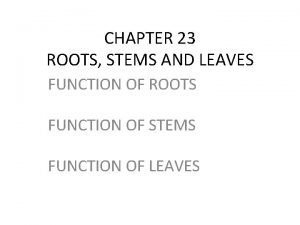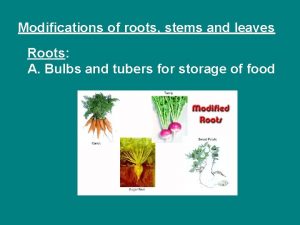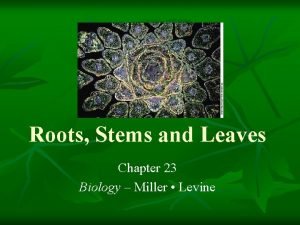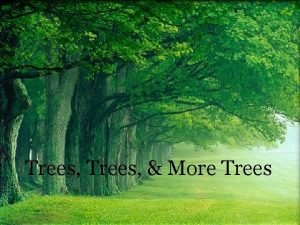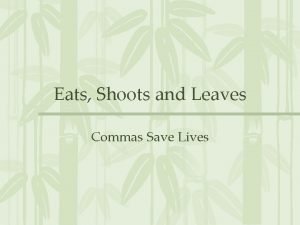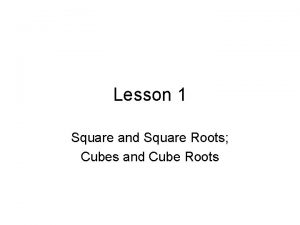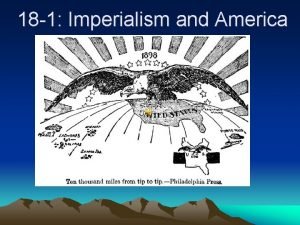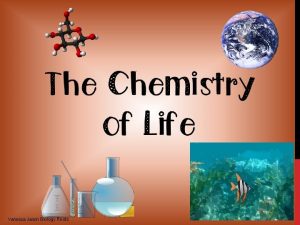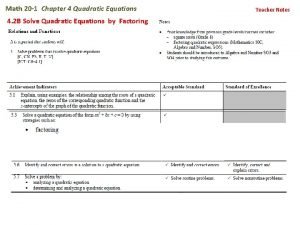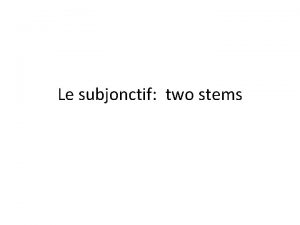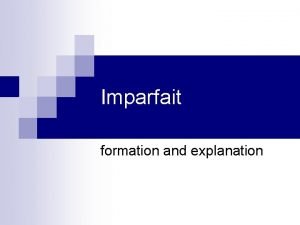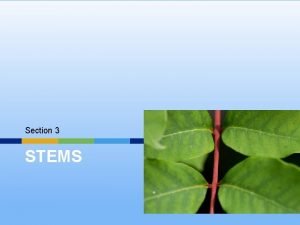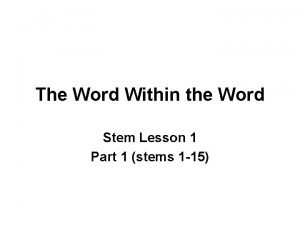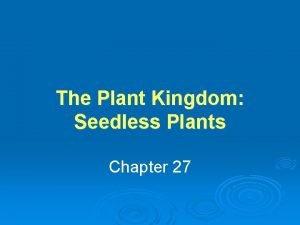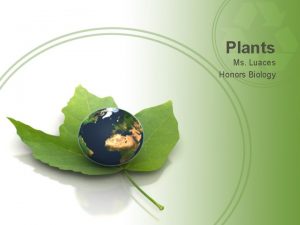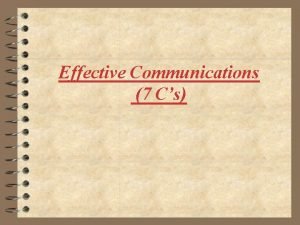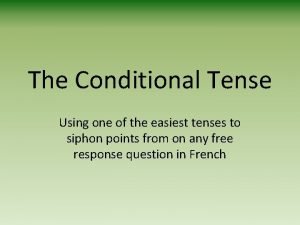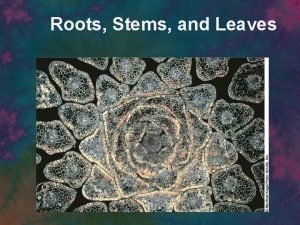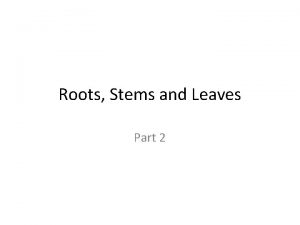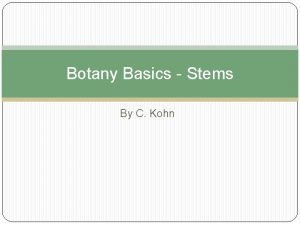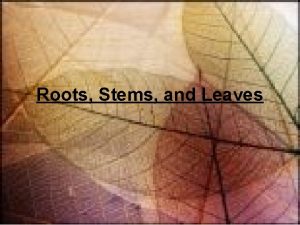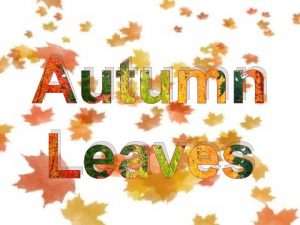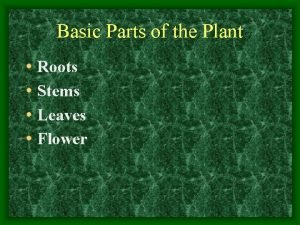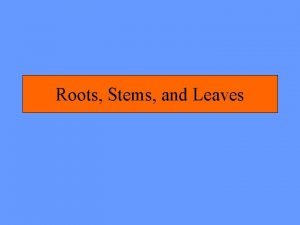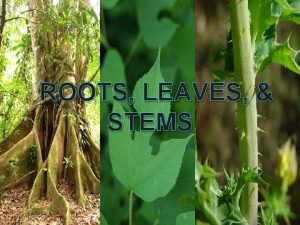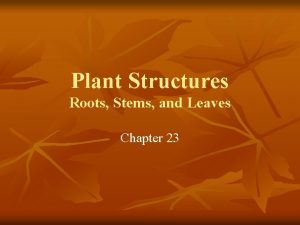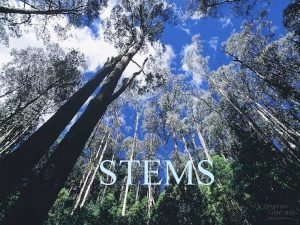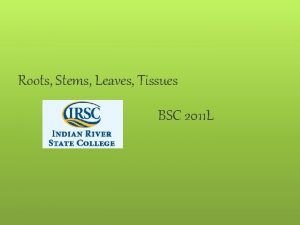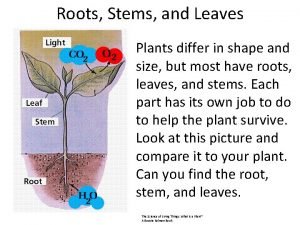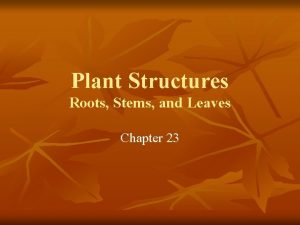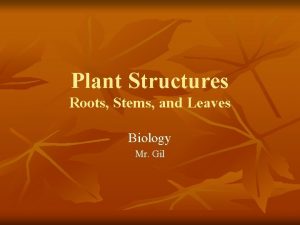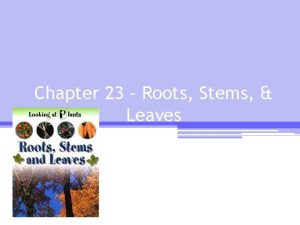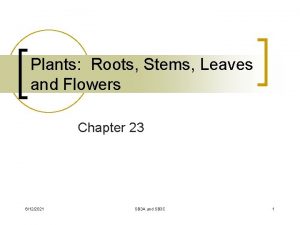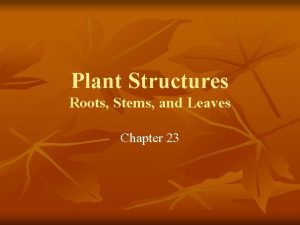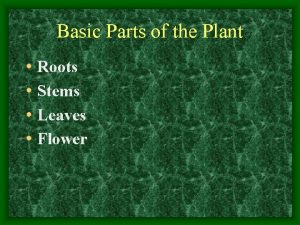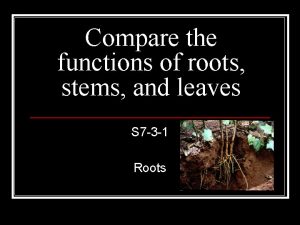Roots Stems Leaves Ch 23 2 Roots o


























- Slides: 26

Roots, Stems & Leaves Ch 23. 2

Roots o Roots function as an _____ and are capable of absorbing _____ and dissolved minerals. o They also have _________ for transporting water & nutrients. o Ideally roots want a large _______ for absorbing water and dissolved minerals.

Roots o They vary in shape: short, long, thick, thin, massive, threadlike o Ideally roots want a large _______ for absorbing water and dissolved minerals.

Roots

Roots o There are 2 types of root systems (depends on environment). n A) taproot = single, thick structures (ex: carrots, beets) n B) fibrous roots = many, small branching roots (ex: grasses, clovers)

taproot fibrous root

Root structure o Let’s look at the layers within a root, starting out and working our way in. is rm e d cle do y ic en er p x c te or is m er id p e Xylem & phloem INSIDE OUTSIDE

Root structure The outermost structure on a root are _______ which increase surface area, ultimately allowing more water, oxygen, & dissolved minerals to be absorbed Next layer = cortex o. The cortex transports water and dissolved minerals into vascular tissue o. Mostly parenchyma cells that store food, water

Root structure Next layer = endodermis o A layer of waterproof cell walls around vascular tissue o This layer controls water flow & dissolved minerals into roots Next layer = pericycle o Produces lateral roots

Root structure Xylem & phloem = in center of root o monocot = vascular bundles surround central core aka pith o dicot = central star

Root structure s t o ro is ic le c y r pe do n e rm e d x te or ir a h is rm c e d i p e Xylem & phloem INSIDE OUTSIDE

Makes it longer Protection

epidermis

Root growth o Region where roots grow in length = ________ o As these newly created cells mature, they differentiate and take on specific functions. o The tip of root is covered by _____ (protective layer of parenchyma cells). o Also, vascular cambium in dicots increases the _____ of roots.

Stem o Supports leaves and flowers o Has vascular tissue to transport water, dissolved minerals, sugars o Herbaceous or woody o Some stems store food (to survive harsh weather) ex: corn, tubers, & rhizomes

Internal structure of stems Vascular tissue appears in 2 arrangements: scattered (monocot) & circular (dicot)

Woody Stems o Examples: conifers, perennial dicots (have thick sturdy stems) o As plants grow up they also g r o w o u t o The added thickness on sides aka “secondary growth. ” It is created by the vascular cambium. o Woody stems have visible annual growth rings with sclerenchyma fibers

Woody Stems outermost Tissue layers innermost

Stems transport materials o Xylem transports _____ and dissolved minerals from _____ to _____ o Phloem carries dissolved _____, hormones, viruses from _____ to ______ “sink” = any portion of plant that stores sugars (ex: parenchyma cells) “translocation” = movement of sugars in phloem

Growth in Stem The term “primary growth” refers to a plant increasing in length along the stem at nodes where they give rise to branches and leaves.

Leaves o Primary function = __________ o Leaves want to have a large ________ to capture light. o Leaf blade = flat broad green structure (vary in size and shape) o Some leaves join directly to stem o Some leaves have a stalk that joins leaf blade to stem n The stalk of a leaf = petiole (has vascular tissue)


Leaf structure o Outermost layer = Epidermis o Next = Mesophyll: Photosynthesizing tissue of leaf n n Palisade mesophyll = photosynthesis occurs here Spongy mesophyll = has lots of air pockets for CO 2, & water vapor to exit via stomata


Transpiration loss of water via stomata = aka transpiration Think PERSPIRATION… when you sweat you lose water through your pores

Leaf modifications o A) Some plants release irritants when crushed or broken o B) Another modification = cactus spines which are modified leaves (to reduce water loss). o C) Carnivorous plants use their leaves to trap insects. o D) Some leaves function as water or food storage sites (ex: aloe vera) o E) Bulb = shortened stem, flower bud and immature leaves n ex: onion, tulips, narcissus, lilies
 Leaf structure cube
Leaf structure cube Leaf roots example
Leaf roots example Functions of the leaves
Functions of the leaves What part of the plant carries and protects the seed
What part of the plant carries and protects the seed Leaves branches trunk and roots song
Leaves branches trunk and roots song Eats shoots and leaves joke explanation
Eats shoots and leaves joke explanation Square root 1 to 100
Square root 1 to 100 Perfect cube list
Perfect cube list Lesson 3 existence and uniqueness
Lesson 3 existence and uniqueness The roots of american imperialism economic roots
The roots of american imperialism economic roots Biology roots vanessa jason
Biology roots vanessa jason Quadratic equation roots
Quadratic equation roots Two stems
Two stems Imparfait formation
Imparfait formation Types of stems
Types of stems Word within the word stems
Word within the word stems Mosses and liverworts
Mosses and liverworts Dok question stems for science
Dok question stems for science Closing sentence stems
Closing sentence stems What is the function of stems?
What is the function of stems? Five stems of od practices
Five stems of od practices Courteous message stems from
Courteous message stems from Higher order thinking iteach flashcards
Higher order thinking iteach flashcards Sat format
Sat format Irregular conditional stems french
Irregular conditional stems french Vocabulary viper
Vocabulary viper Above ground stem
Above ground stem
